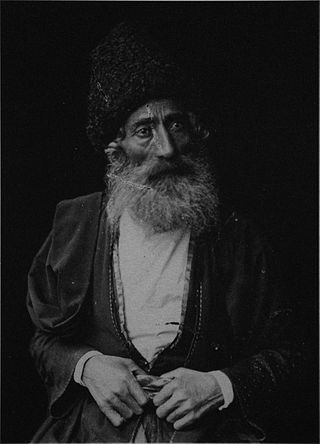Related Research Articles

The Georgian Jews are a community of Jews who migrated to Georgia during the Babylonian captivity in the 6th century BCE. It is one of the oldest communities in the region. They are also widely distinguished from the Ashkenazi Jews in Georgia, who arrived following the Russian annexation of Georgia.

Aliyah is the immigration of Jews from the diaspora to, historically, the geographical Land of Israel or the Palestine region, which is today chiefly represented by the State of Israel. Traditionally described as "the act of going up", moving to the Land of Israel or "making aliyah" is one of the most basic tenets of Zionism. The opposite action – emigration by Jews from the Land of Israel – is referred to in the Hebrew language as yerida. The Law of Return that was passed by the Israeli parliament in 1950 gives all diaspora Jews, as well as their children and grandchildren, the right to relocate to Israel and acquire Israeli citizenship on the basis of connecting to their Jewish identity.
The Law of Return is an Israeli law, passed on 5 July 1950, which gives Jews, people with one or more Jewish grandparent, and their spouses the right to relocate to Israel and acquire Israeli citizenship. Section 1 of the Law of Return declares that "every Jew has the right to come to this country as an oleh [immigrant]". In the Law of Return, the State of Israel gave effect to the Zionist movement's "credo" which called for the establishment of Israel as a Jewish state. In 1970, the right of entry and settlement was extended to people with at least one Jewish grandparent and a person who is married to a Jew, whether or not they are considered Jewish under Orthodox interpretations of Jewish law.

Mizrahi Jews, also known as Mizrahim (מִזְרָחִים) in plural and Mizrahi (מִזְרָחִי) in singular, and alternatively referred to as Oriental Jews or Edot HaMizrach, are terms used in Israeli discourse to refer to a grouping of Jewish communities that lived in the Muslim world. Mizrahi is a political sociological term that was coined with the creation of the State of Israel. It translates as "Easterner" in Hebrew.

The Beta Israel, or Ethiopian Jews, are a Jewish diaspora group that lived for thousands of years in the territory of the Kingdom of Aksum and its successor the Ethiopian Empire, which is currently divided between the Amhara Region and Tigray Region in modern-day Ethiopia. After the founding of the State of Israel in 1948, most of the Beta Israel immigrated there or were evacuated through several initiatives by the Israeli government.
The history of the Jews in Latin America began with conversos who joined the Spanish and Portuguese expeditions to the continents. The Alhambra Decree of 1492 led to the mass conversion of Spain's Jews to Catholicism and the expulsion of those who refused to do so. However, the vast majority of conversos never made it to the New World and remained in Spain slowly assimilating to the dominant Catholic culture. This was due to the requirement by Spain's Blood Statutes to provide written documentation of Old Christian lineage to travel to the New World. However, the first Jews came with the first expedition of Christopher Columbus, including Rodrigo de Triana and Luis De Torres.
The history of the Jews in Cuba goes back to the 1400s. Jewish Cubans, Cuban Jews, or Cubans of Jewish heritage, have lived in the nation of Cuba for centuries. Some Cubans trace Jewish ancestry to Marranos who came as colonists, though few of these practice Judaism today. The majority of Cuban Jews are descended from European Jews who immigrated in the early 20th century. More than 24,000 Jews lived in Cuba in 1924, and still more immigrated to the country in the 1930s. Following the 1959 communist revolution, 94% of the country's Jews emigrated, most of them to the United States. In 2007 an estimated 1,500 known Jewish Cubans remained in the country, overwhelmingly located in Havana. Several hundred have since immigrated to Israel. Considered one of the most important Latin American Jewish sites, Beth Shalom Temple is the epicenter for current Jewish life in Cuba and still conducts weekly Shabbat services.

HIAS is a Jewish American nonprofit organization that provides humanitarian aid and assistance to refugees. It was established on November 27, 1881, originally to help the large number of Russian Jewish immigrants to the United States who had left Europe to escape antisemitic persecution and violence. In 1975, the State Department asked HIAS to aid in resettling 3,600 Vietnam refugees. Since that time, the organization continues to provide support for refugees of all nationalities, religions, and ethnic origins. The organization works with people whose lives and freedom are believed to be at risk due to war, persecution, or violence. HIAS has offices in the United States and across Latin America, Europe, Africa, and the Middle East. Since its inception, HIAS has helped resettle more than 4.5 million people.
Judeo-Iraqi Arabic, also known as Iraqi Judeo-Arabic and Yahudic, is a variety of Arabic spoken by Iraqi Jews.
In the wake of the 1999–2002 Argentine political and economic crisis, many Argentine Jews emigrated to Israel. The 1992 attack on the Israeli embassy and the 1994 bombing of the Jewish Community Center in Buenos Aires also helped create an impetus for Jews to emigrate.
In the years leading up to the dissolution of the Soviet Union in 1991 and for just over a decade thereafter, a particularly large number of Jews emigrated from the Soviet Union and the post-Soviet countries. The majority of these emigrants made aliyah, while a sizable amount immigrated to various Western countries. This wave of Jewish migration followed the 1970s Soviet aliyah, which began after the Soviet government lifted the ban on the country's refuseniks, most of whom were Jews who had been denied permission to leave the country.
Israeli Jews or Jewish Israelis comprise Israel's largest ethnic and religious community. The core of their demographic consists of those with a Jewish identity and their descendants, including ethnic Jews and religious Jews alike. Approximately 99% of the global Israeli Jewish population resides in Israel; yerida is uncommon and is offset exponentially by aliyah, but those who do emigrate from the country typically relocate to the Western world. As such, the Israeli diaspora is closely tied to the broader Jewish diaspora.

In Israel, prisoners of Zion were Jews who were imprisoned or deported for Zionist activity in countries where such activity was prohibited. The former Speaker of the Knesset, Yuli Edelstein, and the former chairman of the executive of the Jewish Agency, Nathan Sharansky, were both prisoners of Zion in the Soviet Union. In 1992 an Israeli law made the status of the prisoner of Zion official, however the status was in use long before.
Ethiopian Jews in Israel are immigrants and descendants of the immigrants from the Beta Israel communities in Ethiopia who now reside in Israel. To a lesser, but notable, extent, the Ethiopian Jewish community in Israel is also composed of Falash Mura, a community of Beta Israel which had converted to Christianity over the course of the past two centuries, but were permitted to immigrate to Israel upon returning to Israelite religion—this time largely to Rabbinic Judaism.

The history of the Jews in Uruguay dates back to the colonial empire. The most important influx of Jewish population occurred during the end of the 19th century and the first half of the 20th century, mainly during World War II.

Kurdish Jews in Israel are immigrants and descendants of the immigrants of the Kurdish Jewish communities, who now reside within the state of Israel. They number between 150,000 and 300,000.
South African Jews in Israel are immigrants and descendants of the immigrants of the South African Jewish communities, who now reside within the State of Israel. In 2020, 11,381 South Africans were recorded as living in Israel.

Bulgarian Jews in Israel are Jewish immigrants and descendants of the immigrants of the Bulgarian Jewish communities, who now reside within the state of Israel. They number around 75,000 in the wider definition, and 7,500 in the narrower scope.

The history of the Jews in Paraguay has been characterised by migration of Jewish people, mainly from European countries, to the South American nation, and has resulted in the Jewish Paraguayan community numbering 1,000 today.
Russian Jews in Israel are immigrants and descendants of the immigrants of the Russian Jewish communities, who now reside within the State of Israel. They were around 900,000 in 2007.
References
- 1 2 "Where did Uruguayans go?". El Observador. 13 August 2017.(in Spanish)
